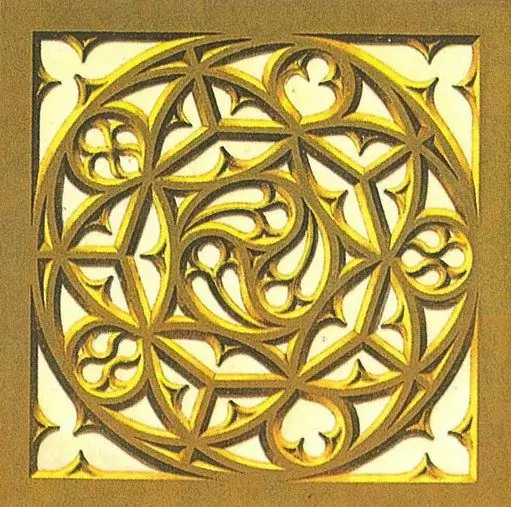The main task of the ornament is to create a beautiful frame that emphasizes and sets off the main element. When designing a Gothic ornament, a ruler and a compass are used, since in this technique there is much more from drawing than from drawing.

Basic techniques of artistic Gothic
The Gothic style is characterized by straight intertwining vertical and arcuate lines, circles with repeating fragments and stylized plant motifs. The principle of constructing a Gothic ornament is most clearly reflected in the masverk pattern, which is used for openwork decoration of wood and stone products, fireplaces and stained-glass windows. In the Gothic decor, there are quite a few ornaments based on the image of plants, mainly thorny (thistle, blackthorn, wild rose) whose uneven natural silhouettes are very consistent with the style of the era. Gothic is distinguished by straight and clear lines, this opens up a huge scope for imagination in drawing up geometric ornaments.
The image of mythical creatures is considered a valuable element of Gothic ornament. Zoomorphic and anthropomorphic motifs can reflect legends and fairy tales. The canon is the image of a woman's head on the body of a bird or fish, a human face turning into the crown of a tree, animals and people with wings in unnatural, broken poses.
Creating a motive
Starting to draw a Gothic ornament, it is necessary to immediately outline the boundaries of the element beyond which the drawing should not go. To make the task easier, you can draw a frame with a simple pencil, after finishing the work, erase the lines with an eraser.
They begin to draw a geometric pattern from the middle of a conditional square, connecting straight lines with semicircles and arcs. The most convenient way to do this is with a ruler and compasses. The most famous Gothic symbol is the depiction of one schematic royal lily on a high stem, or 4 flowers tied together.
The base of the plant pattern runs through the entire element and is drawn first. In Gothic, as a rule, the base of the ornament is a tree trunk or a branch, onto which additional elements are then strung: leaves, flowers or bunches. A wavy or zigzag line is drawn around which smaller details are then placed.
Ornament formation
The repetition of the same pattern creates a single-motive pattern; this technique is used for ribbon framing of paintings and for decorating furniture. If you dilute the plant elements with repeating geometric motifs, you get the so-called border, which is used to frame volumetric objects. When creating a Gothic ornament on a computer, it is convenient to use the technical capabilities of copying to combine repeating motifs in a pattern.






